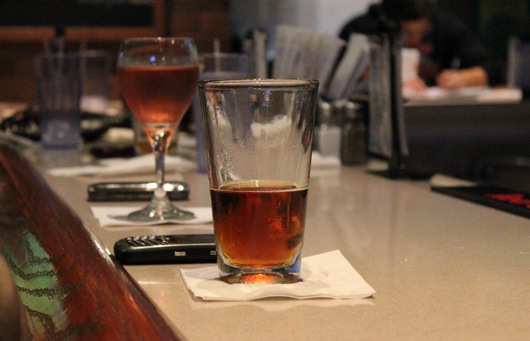Study points to dangers of lower drinking age

Diners over the age of 21 enjoy an alcoholic refreshment during lunch recently at The Rathskeller. (George Yanez)
The effect of lowering the national drinking age from 21 to 18 would be devastating for teenagers according to a recently released study by George Mason University, but a national initiative is pushing for the drinking age to be reexamined.
More than 100 college presidents from around the country have signed the Amethyst Initiative, which was formed in 2008 and says it is time to rethink the current drinking age of 21.
While the initiative doesn’t specifically say the drinking age should be lowered to 18, it does say, “the problem of irresponsible drinking by young people continues despite the minimum legal drinking age of 21.”
However, according to a report released by Mason researchers, the effects of lowering the drinking age would be primarily negative.
The College Alcohol Survey was conducted by David Anderson a professor in the Center for the Advancement of Public Health and Angelo Gadaleto a professor at West Chester University.
The survey asked 203 college and university representatives from around the country a variety of questions about underage drinking on and off college campuses.
According to the report, if the drinking age were lowered to 18, 70 percent of the chief student affairs officers at the universities polled believe there would be some or a high increase in campus problems related to alcohol.
Another 69 percent of college representatives believed there would be some or a high increase in a frequency of impaired driving, if the drinking age were lowered.
The Specifics
The drinking age in the United States was raised to 21 in 1984 with the passing of the National Minimum Drinking Age Act in Congress.
States that do not comply with the national legislation face a 10 percent reduction in federal grant money for highways under the Federal Highway Aid Act.
Each year approximately 5,000 young people die under the age of 21 as a result of underage drinking, according to the National Institute on Alcohol Abuse and Alcoholism.
According to the George Mason University Police, 93 people were arrested for driving under the influence in 2009. As of September 29, 37 people have been arrested for that same offense.
The Amethyst Initiative asked the wrong question, Anderson said.
“The real question is how do we reduce high risk decisions around alcohol?”
The answer he says is not to necessarily focus on the age people are drinking, but to help anyone who is making unwise decisions concerning alcohol.
High risk decisions include drinking and driving, risk to personal health, and disruptive consequences to others.
Anderson says the answer to stopping these types of behaviors can be in parental involvement, talking about the effects of alcohol in high school, and having safe ride buses available to people who have been drinking.
According to Anderson the Amethyst Initiative only stirred the pot and the vast majority of people questioned don’t believe the drinking age should be lowered. He said the Initiative only has 135 university presidents’ signatures while there are thousands of universities around the country.
The Arguments
The Initiative makes the argument that if the drinking age were to lowered to 18, the same rules could be applied when a teenager is applying for a driver’s license.
Rather than automatically being allowed to drink alcohol, the teenager would have to pass a test and take a class about the harmful effects of alcohol.
Another argument that has been used by supporters of lowering the drinking age is that if an 18 year old can fight for his or her country and cast his or her vote at the ballot box then why should they not be able to drink a beer?
According to Students against Drunk Drivers three out of every four students (75%) have consumed alcohol (more than just a few sips) by the end of high school. Another 41% or two fifths of students of students’ have consumed alcohol by 8th grade.
Some opponents of lowering the drinking age argue lowering the age to 18 would have a reverse effect and more high schoolers would have access to alcohol.
SADD also estimates that 24,650 lives have been saved by minimum drinking age laws since 1975.
Reality of Lowering Drinking Age
Since the Initiative was formed in 2008 there has been no national legislation proposed to lower the drinking age. While the Initiative drew national attention for its bold statement, no legislators have picked up on the message.
Anderson believes the initiative is not likely to have an impact on congress as it stands currently with a proposal to force a lower drinking age.
The question of lowering the drinking age is an ethical question, said Anderson. “Data is very clear, don’t touch it,” said Anderson.
